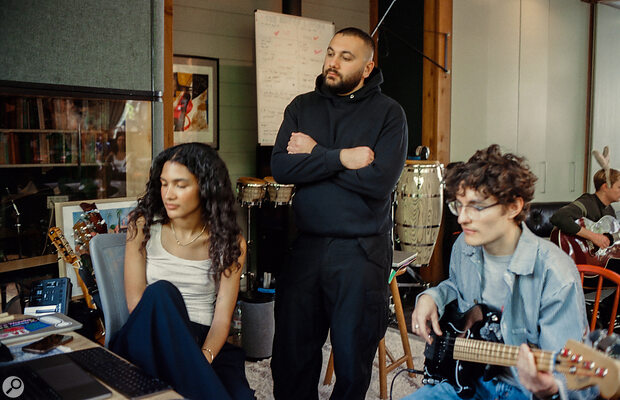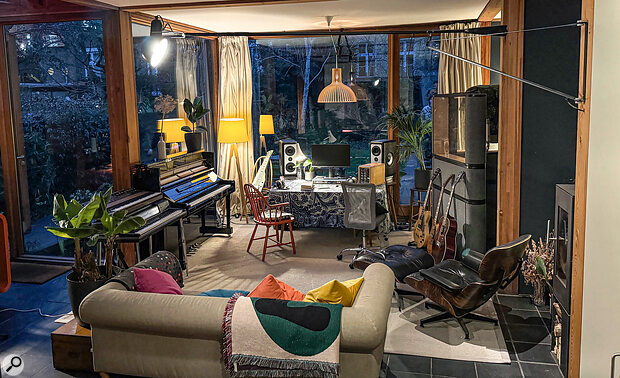 Zach Nahome (centre) with Olivia Dean and bassist Finn Zeferino‑Birchall.
Zach Nahome (centre) with Olivia Dean and bassist Finn Zeferino‑Birchall.
To perfect Olivia Dean’s intimate, personal sound world, the artist and producer/songwriter Zach Nahome decided to step outside the studio.
One of the UK’s leading producers and songwriters, Zach Nahome’s credit list contains prominent names like Bakar, Loyle Carner, PinkPantheress, Slowthai and Celeste. Recently, Nahome hit the big time with Olivia Dean, as co‑writer, co‑producer and executive producer on the British singer’s second album The Art Of Loving, and its lead single ‘Man I Need’, both of which went to number one. “My process tends to be to go into a room with the artist with nothing, and leave with a song written,” says Nahome. “I also tend to lay down the demos. I’m not the best guitarist or pianist or drummer, but I figure it out.
“When I started working with Olivia, she brought in a few songs that had already been written when I got involved, so my job was to help develop and finish them, as well as write new ideas together. Still, the overall process with her was the same. The record started from within and from an internal dialogue, rather than considering an audience too much. The Art Of Loving is an ambitious record, and if your ambition is to really make the best music, the byproduct is that it will appeal to many people.”
A Room Of One’s Own
“When we were talking about where to start work on the record, she was thinking studios, but nothing felt exciting. At that point, she found all recording studios quite uninspiring and impersonal. So the idea came about to convert a house into a studio.
“It’s quite difficult to find a place in London where you can make noise, but in the end we found a big house in East London that was perfect. We set up a studio in a big kitchen/living area with big massive glass windows looking onto a garden. It felt very open. The house was really cool, and we ended up working there for two and a half months. Olivia even stayed there part of the time. We’d often cook whilst making music, or I’d be in the kitchen making pasta whilst leaving something on loop to listen to. That studio became our biggest tool in creating these songs. Equipment is great and amazing, but honestly, the room is the most important. By miles.”
 Much of The Art Of Loving was written and recorded in a London house rented especially for the purpose.
Much of The Art Of Loving was written and recorded in a London house rented especially for the purpose.
Nonetheless, equipment remains essential, and Nahome recalls, “We brought in loads. We obviously had an obstacle in that room. The acoustics weren’t going to be incredible because there’s glass everywhere, so we had some baffles put in and built a vocal booth. I used a pair of Barefoot MicroMain27s, which are really good. We linked two [Universal Audio] Apollo x8ps together in order to get 16 preamp channels. We wanted to be able to just plug in and go. Everything was done in Logic, the DAW I have used for my entire career.”
House Music
“We brought Olivia’s piano over from her home, and she also brought in her nylon‑string guitar, which she loves. Rebecca Ellis at Gibson gave us loads of guitars to play with, which was great, and I also brought some guitars from my studio. We had a vintage Prophet‑5 and a Wurlitzer, and two drum kits: a vintage Gretsch and a vintage Ludwig. We also had lots of microphones, and tried several on the drum kit, but I ended up removing half of them because I didn’t love the sound of over‑miking a drum kit in that environment. It sounded better using less, so I used just a Shure SM57 as overhead, another 57 on the snare, and I think the kick mic was a Sennheiser e902. Electric and bass guitars were recorded DI, which gives me more control over the sounds I want.
“I’m less bothered by what mics there are on the drums, but I care a lot about what mic I use on vocals, and in this case a friend of mine lent me an amazing microphone. All her vocals and all acoustic guitars recorded in the house went through this AKG C12. We also recorded all the backing vocals on the C12, set to omni. We wanted to feel the house. The house was quite noisy, and we wanted that to be audible. The sound of the house became part of the sound world for the album, one of the common threads that holds it together. That C12 also was a really big part of this record. I ended up buying it, because of how important it became to my process. That particular mic has a lot of history. It used to belong to Olympic Studios in London and then to Dusty Springfield, who recorded most of her songs with it. It’s incredible.
“We also often used the Teenage Engineering TP‑7. It’s almost like a tape recorder. There were a lot of noises around the house in East London. It was next to a school and the garden had amazing birds. I recorded a lot of the sounds of the environment that we were in with the TP‑7. I also use my iPhone all the time. Sometimes I record vocals or drums solely through Voice Notes. The amount of times I’ll use the iPhone for recording guitars and pianos is amazing. Also on this album. Many of the songs may sound lush and big, but there’s this weird intimacy that you get from how your iPhone makes things sound, that spoke to the personal element that we were after.”
Less Is More
Many other writers and producers are credited on The Art Of Loving, including Bastian Langebaek, Max Wolfgang, Matt Hales and Tommy Danvers, and American production and writing heavyweights like John Ryan, Julian Bunetta, Amy Allen, Tobias Jesso Jr and Nolan Lambroza. According to Nahome, most of their work on the songs took place before the East London sessions.
“As I mentioned, some of the songs pre‑dated her and I meeting. For example, the year before, Olivia had worked in America on a song with John Ryan and Amy Allen. Julian Bunetta and John later also offered some work on the production of songs like ‘Close Up’ and ‘Let Alone The One You Love’ on the drums and brass, in particular, which was great. Moreover, Olivia has worked with guys like Bastian, Max and Matt for a long time, and they are an integral part of her writing process. They make great songs together.
“Some of these songs, because of the idea of the record being super‑personal, had to be on the record. Tobias Jesso Jr, Max Wolfgang and Bastian also worked at the house in East London, and some of the additional production from John and Julien took place around that time remotely. All songs went through my computer at some point or other, and we tried to elevate them. For example, when I first heard ‘Let Alone The...
You are reading one of the locked Subscribers-only articles from our latest 5 issues.
You've read 30% of this article for FREE, so to continue reading...
- ✅ Log in - if you have a Digital Subscription you bought from SoundOnSound.com
- ⬇️ Buy & Download this Single Article in PDF format £0.83 GBP$1.49 USD
For less than the price of a coffee, buy now and immediately download to your computer, tablet or mobile. - ⬇️ ⬇️ ⬇️ Buy & Download the FULL ISSUE PDF
Our 'full SOS magazine' for smartphone/tablet/computer. More info... - 📲 Buy a DIGITAL subscription (or 📖 📲 Print + Digital sub)
Instantly unlock ALL Premium web articles! We often release online-only content.
Visit our ShopStore.
